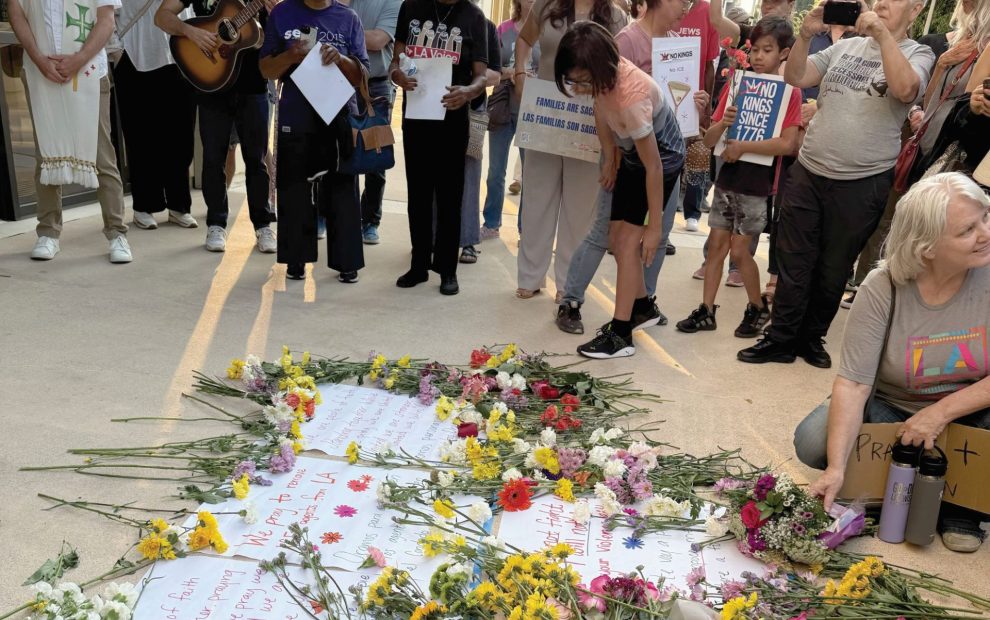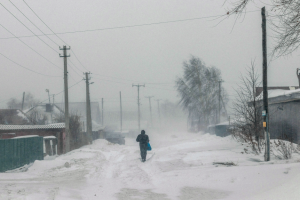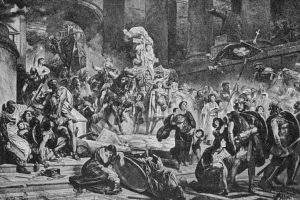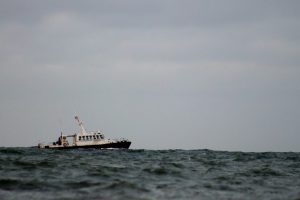It’s a warm, sunny day as I prepare my backpack, borrow one of my son’s refillable water bottles, and grab a couple of protein bars. You would be justified in thinking I am getting ready for a hike, but this isn’t a hike. I am heading out to be in community, to practice accompaniment and remembrance with and for the pilgrims who are the world’s displaced people. Like the immigrants with whom I stand in solidarity, I am setting out as a pilgrim.
I wrap a bouquet of small white roses in a dampened cloth napkin to keep them hydrated and pick up a bag with a banner inside. I double-check everything. A small Salvadoran cross—a symbol of solidarity and remembrance—hangs over my T-shirt, proclaiming, “Still Here, Still Rising,” with butterflies and “Resilience” printed across the back.
“Resilience” is the name my students chose for their immigration advocacy group after the DREAM Act was defeated in Congress 15 years ago. Today, some of those same students lead efforts in organizing advocacy and ministry to migrants. Resilience is also a requirement of any genuine pilgrimage—including the pilgrimage that is immigration.
A pilgrimage is not a vacation. It is a recollection, in and through our bodies, of life’s unsettled quality and the effort of living faithfully. Experienced in this way, as a communal act, walking in pilgrimage can help us see God at work in all things. As we awaken to the sacredness of daily life and all who share it with us, the gospel’s central affirmation that love of God and love of neighbor are always inextricably joined moves from idea to experience. If we fail to love our vulnerable neighbor, we are failing in loving God. This unconditional love is often inconvenient, requiring resilience and commitment. Both immigration and pilgrimage can witness to persistent love.
The sacred place
On this day, I join hundreds of people converging on the spot where El Pueblo de Nuestra Señora Reina de Los Ángeles de la Porciúncula was established in 1781. Sometimes called simply LA, or more evocatively, the City of Angels, Los Angeles was built by courageous people in search of better lives for their families. The long story of both internal and external migrations also shaped most of our entire country. Sadly, our desire to forget this truth—to tell a false story of America’s “racial purity”—conceals the pain of the people we conquered. Our insistence on America’s “exceptionalism” is at the root of today’s epidemic of xenophobia.
Los Ángeles was multiethnic and multiracial from its very beginnings. The original 44 settlers were Indigenous, African, and European, joined by their beautifully mixed-race progeny. The city’s forebears journeyed more than a thousand miles to reach this place, through the vast lands that were New Spain, later called Mexico, and finally to the present-day United States.
Most Angelenos still lovingly call the birthplace of our city “La Placita,” the little plaza, which is also the name most of us give the Catholic church there. The first church in the region, Nuestra Señora Reina de Los Ángeles moved to its present location near La Placita in the early 1800s. Today, this parish is the first to welcome and assist people on the move—immigrants and refugees whose lives and human dignity are under attack by federal authorities. Meanwhile, our own residents and elected officials oppose the federal government’s actions.
Today, as we converge on La Placita, joined in our opposition to ICE’s constant terrorizing of our communities, we come from all corners of the sprawling metropolis of today’s Los Angeles. We proclaim the sacredness of families in a prayer walk for immigrants organized by communities of faith of every denomination. Like the first group who made their way to this land, we are many colors, and as their descendants, we are also many faiths. The community sings and prays in the diverse faith languages of Catholics, Protestants, Jews, Muslims, and Indigenous communities. And like those immigrants who first arrived here, we set out on foot.
The spiritual significance of walking
In his book, Mañana: Christian Theology from a Hispanic Perspective (Abingdon Press), church historian Justo González points out that “innocent history is a selective forgetfulness, used precisely to avoid the consequences of a more realistic memory. Responsible remembrance, on the other hand, leads to responsible action.”
González sees this need to remember responsibly as foundational to Christianity, adding, “A clear example is in the repeated injunctions to Israel: ‘You shall not wrong a stranger or oppress him, for you were strangers in the land of Egypt.’ ‘Love the sojourner therefore; for you were sojourners in the land of Egypt;’ and an even more radical consequence of that memory of pilgrimage, ‘The land shall not be sold in perpetuity, for the land is mine; for you are strangers and sojourners with me.’ ”
Our prayer walk is meant to remind us precisely of our transience on God’s Earth and of the absurdity of any human claim to land ownership or the right to build walls. These are an affront to God’s ultimate sovereignty.
This insight into the joint purpose of faith and action was also a hallmark of Pope Francis’ approach: What we do for others is, in the end, extremely good for us too, nurturing our own growth in faith. As the pope said in his 2025 message of preparation for Lent, it is good for us to “compare our daily life with that of some migrant or foreigner, to learn how to sympathize with their experiences and in this way discover what God is asking of us.”
Faith in action
As we pray at this protest, one clear conviction unites us, eloquently expressed by Jesuit Father Brendan Busse, who proclaims that immigration “is not an invasion; it is a family gathering.” Busse is pastor of the legendary Dolores Mission Church, established in 1925, less than two miles from La Placita and a model of what an active faith community can do to bring justice to the world around it.
This parish constantly asks: “What is God asking us to do, here and now?” The response has flowered into far-reaching projects, among them Homeboy Industries (today the largest gang rehabilitation program in the world), the Coalition for Humane Immigrant Rights LA (CHIRLA), and the Guadalupe Homeless Project.
Now, as we reach the federal building together, under the gaze of the guarding police officers, we place flowers on the steps until the space is covered with their fragile beauty. Each flower represents our love for every immigrant the Department of Homeland Security has detained and mistreated. Then we sing, “Lord, Prepare Me to Be a Sanctuary.” Many of us weep.
The pilgrim seeks shelter in trust that hospitality will be offered—and hospitality is a requirement of Christian faith. As Hebrews 13:2 reminds us, we cannot “neglect hospitality, for through it some have unknowingly entertained angels.” The pilgrim’s fate is in the hands of others, and those who receive them are obliged by their faith to care for them.
If we understand migration as pilgrimage, we can see the depth of trust required of those who come to our country—and the responsibility incumbent on the rest of us to offer hospitality and safety. Like the holy family, who knocked on many doors before a stable was offered, migrants on the road are in need of shelter.
What would we have offered Mary and Joseph if we had been there? Listen! They’re knocking now. How will you respond?
I invite you to add this to your daily prayers: Pope Francis, protector of immigrants, pray for us.
This article also appears in the October 2025 issue of U.S. Catholic (Vol. 90, No. 10, page 21-22). Click here to subscribe to the magazine.
Image: Cecilia González-Andrieu













Add comment